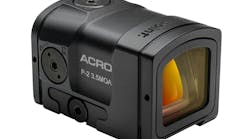Any SWAT commander will tell you they want as many options as possible on the table during an operation. It does not guarantee success, but it increases the likelihood of success. One such option is the use of an Aerial Platform (AP). I will refer to it this way but it is also referred to as Aerial Gunnery, Aerial Marksmanship and Aerial Platform Interdiction depending on who you might be speaking with. Aerial Platform is defined as the placing of accurate rifle fire from a hovering, crawling or moving helicopter in support of a tactical operation. This article will focus on the deployment and issues surrounding the law enforcement community.
Potential road blocks
The mere mention of training your SWAT officers to fire from the agency’s helicopter usually ends up in a short conversation with the chain of command, if they are not open minded people. With the recent increased spotlight on the militarization of the police, this discussion may prove to be even more difficult but is one that needs to be had. If your agency has a helicopter then likely it is responsible for a large amount of area to respond to and/or your agency is of a good size. If you are a member of SWAT, then perhaps it’s time to explore the possibilities of AP being a viable option during certain operations.
If your chain of command is open to the training and deployment of this option then the next trip is down to aviation hangar to talk with the pilots and tactical flight officers (TFOs). What you may encounter next is unknown. Some pilots are open to training AP and some are not. Like I said earlier, you need open minded people that will not make their decision as soon as the words ‘shoot from the helicopter’ are uttered. There is not really a rhyme or reason why pilots will say yes or no. I once thought the old head pilots would be opposed to it, but have been proven wrong. Many are eager to help. Younger pilots may have their reservations, some depending on the amount of flight hours under their belt and their comfort level. Regardless, the pilots and the shooters are the two critical components to operational success.
Justification
Why would you need this tactical option? This is the most prevalent question you will be asked. For those officers that have been on for any amount of time, undoubtedly you can recall incidents where if you had the option of a trained SWAT operator in a helicopter it could have benefited the incident through observation and/or accurate rifle fire to end the crisis. There is no substitute for a SWAT officer in the helicopter communicating with another SWAT officer on the ground. This is by no means meant to lessen anything the Pilots/TFOs may have to communicate, but something usually is lost in translation. There is a long list of incidents where AP would be of great benefit. The following is just a few and is not all inclusive:
- High structures with armed suspect;
- isolated rural areas where suspect(s) is at large;
- protective overwatch on warrant service or barricaded subjects;
- vehicle pursuits where public safety is at risk;
- Active shooter(s) in open areas;
- terrorists attack on a structure or in pursuit.
AP can greatly increase officer safety from the air as ground officers close in on suspect(s). The list goes on. Aerial Platform is a specialty within the specialty of the SWAT team. When the tactical flight officer has to resort to pulling his handgun or shotgun on a dangerous pursuit and pointing it out the door, matters need to be revisited as this may not be the best way of doing things.
3 common excuses
The first excuse that may be used is that your chain of command is confident about your weapon skills on mother earth, but when you talk of firing 100 or 150 feet in the air while moving, suddenly your weapon skills have taken a nose dive. There is a proven mathematical formula for engaging a static target while the aircraft is moving (by the way this is the most difficult of scenarios). This formula was developed by someone far more intelligent than myself. It works and has been validated by SWAT officers. Back to the excuses we go. The concern about where the projectile goes after it exits the bore and travels towards the intended target is a valid concern and one that can be explained. Foreground and background concerns are all still paramount when firing from the aircraft. If aircraft speed and lag hold are not achieved, then the officer may elect to not fire depending on the circumstances. Nothing has change as the officer is still responsible for where the bullet goes. The license to be airborne does not give the officer carte blanche in firing. Collateral human damage is just as great on the ground as in the air. The only thing that has changed is the platform is elevated and the closed minded believe this to be a riskier endeavor as it could possibly have collateral damage and political ramifications. We live in a highly dangerous world and our profession is meeting that face on to save lives.
The second excuse is jet fuel costs. What is not realized is that most aviation units are going to fly a certain amount of hours each day regardless. Fuel costs are over exaggerated and are thrown out there as a convenient excuse. A proper AP training session can last only a few hours (flight time) and does not have to break the agency’s pocket book. Do the research at your agency and you will most likely find the holes to poke in it.
The third excuse is lack of formalized training and lack of any other law enforcement agency having an aerial platform program. Now is when they are grasping at straws. Formalized training for aerial platform exists. There are several legitimate training companies in the United States that provide this valuable training. Most are taught by former Special Forces operators but there are some SWAT instructors too. Do your research and seek out the best that fits your needs. This is where you will get the formalized training you need. If you are taught correctly, you can replicate this training for those selected on a quarterly, biannual or yearly basis. I will caution you this. The key to success with aerial platform is training, training, training. You should not go the route of receiving formalized training and then fall off the cart. Training must be documented and consistent for equipping your officers to have operational success. There are more agencies than you realize that have aerial platform programs in law enforcement. Granted, most exist in the large urban areas, but not all. Network with agencies that do and find out where they got their training.
Who gets put in the helicopter
Another valid question is who on the team is best prepared to serve as the observer and potentially shooter from the aircraft. First let me make this statement. Firing a carbine rifle from the helicopter is not as hard as one might think. Actually, performing this task on demand with accuracy is something that most seasoned SWAT operators can do. Again, it comes back to the ‘T’ word, training. Most LE agencies opt to train and have the police snipers in this role. The reasons are several. At times they operate on their own separate from the assaulters and are used to performing skilled tasks with little help. With this said, they may not be counted on as a ‘body’ to fill a role on the inner perimeter with the other assaulters. In other words, it’s easier for them to pull away for this assignment. Lastly, they usually have more refined skills in the fundamentals of precision marksmanship and how to apply them when firing a rifle from an aircraft. Again, this is a decision that is best left up to your individual agency.
Closing thoughts
Thinking that Aerial Platform is a ‘military type’ operation that has no value in law enforcement is old and antiquated thinking; the closed minded type. The same thinking that did not believe commercial airliners would be flown into skyscrapers. If your agency has an aviation unit and operates police helicopters, then you owe it to the citizens you serve to explore and begin an Aerial Platform program in your agency. If you find yourself having been placed in this position in a crisis, and have not been set up for success with formalized training, demand it for you and your team.
Stay safe and take care of your brothers and sisters in Blue!


